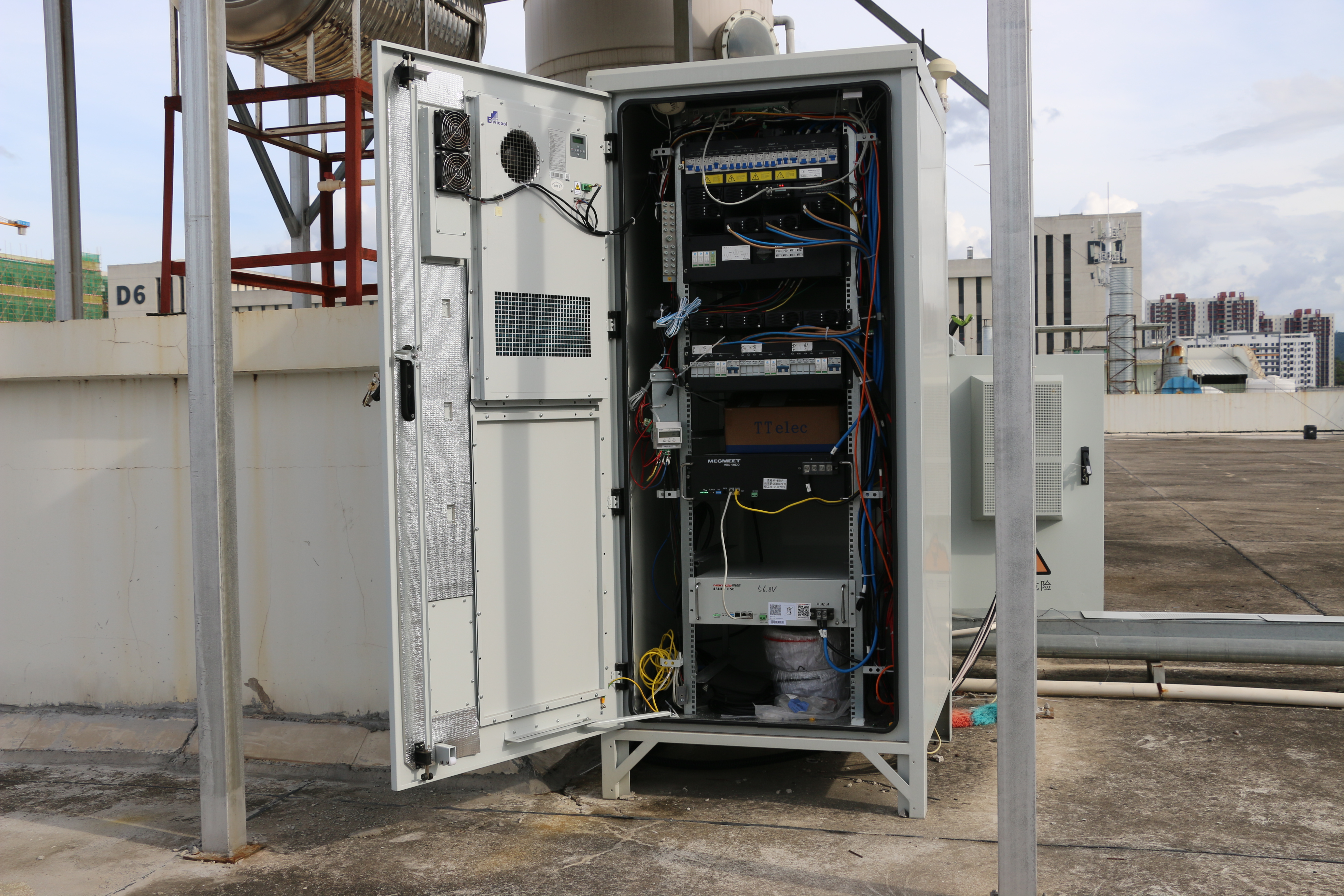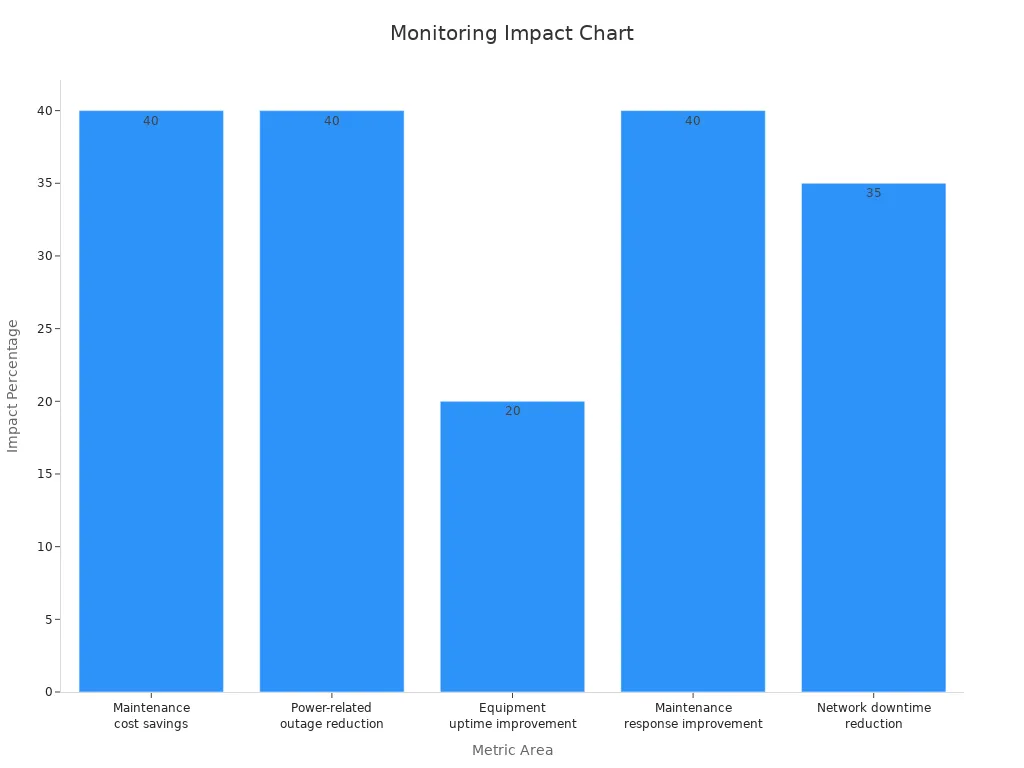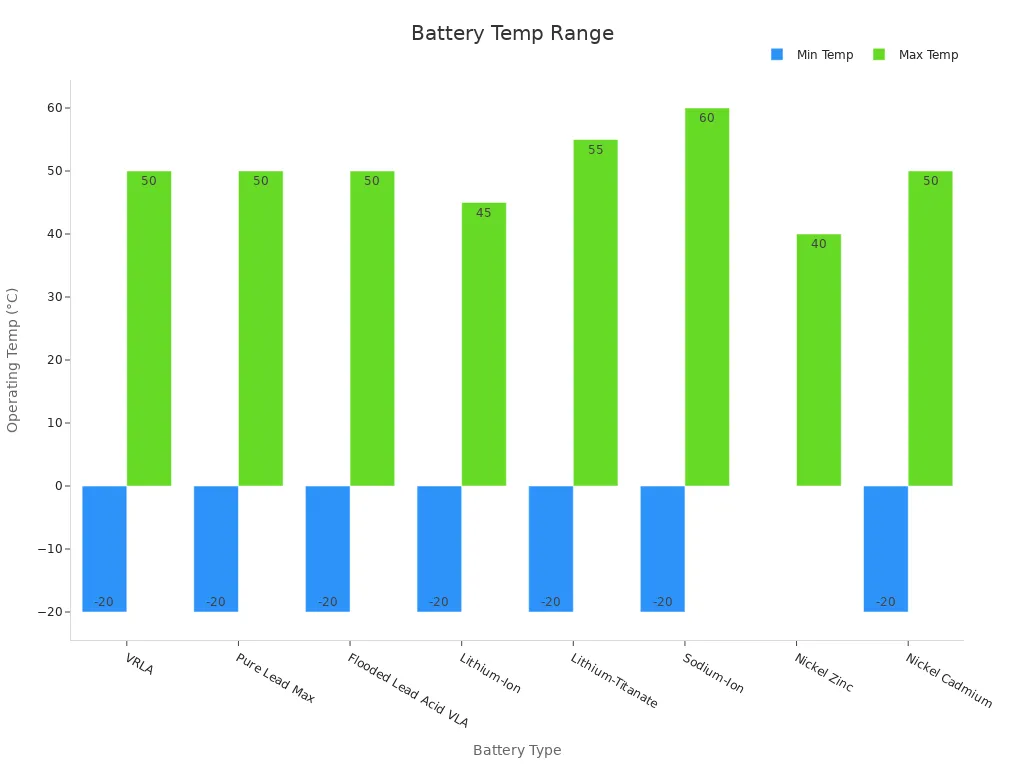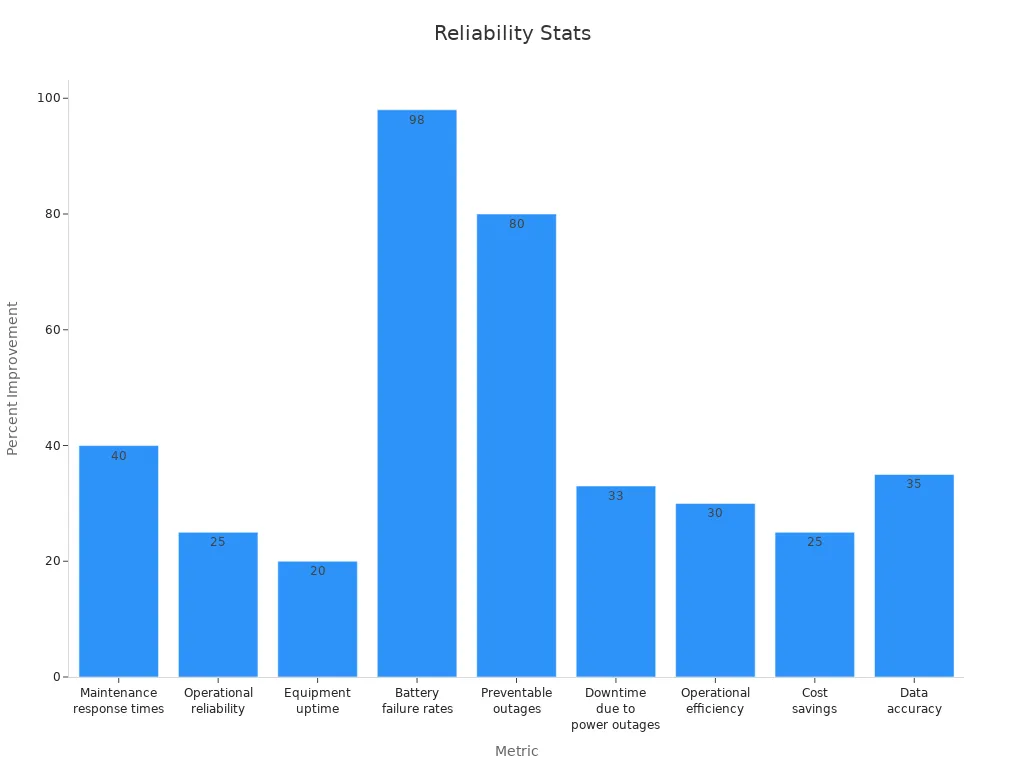Why Investing in Remote Environmental Monitoring Units Protects Outdoor Telecom Cabinets

Remote environmental monitoring units play a critical role in safeguarding outdoor telecom cabinets against costly failures. These systems enable operators to prevent overheating, water ingress, and unauthorized access, which directly reduces downtime by 15% to 25% and cuts maintenance costs by up to 40%. The following data highlights the impact of these units:
Metric Area | Reported Impact / Percentage |
|---|---|
Downtime reduction | 15% to 25% |
Maintenance cost savings | Up to 40% over reactive maintenance |
Power-related outage reduction | Up to 40% |
Energy use reduction | Up to 30% |
Equipment uptime improvement | 20% increase with intelligent monitoring |
Maintenance response improvement | 40% faster response times |
Energy consumption reduction | 15% to 18.2% |
Network downtime reduction (major operator) | 35% reduction, saving millions annually |

Operators see real improvements in reliability, faster response times, and longer equipment life when they deploy remote environmental monitoring units for outdoor telecom cabinets.
Key Takeaways
Remote environmental monitoring units help prevent costly failures by detecting temperature, humidity, and security threats early.
These units reduce downtime by up to 25% and cut maintenance costs by up to 40% through real-time alerts and predictive maintenance.
Monitoring systems improve energy efficiency by optimizing power use, saving up to 20% in energy consumption and lowering operational costs.
Remote access and integration allow operators to manage multiple sites quickly and reduce the need for on-site visits.
Investing in these units boosts equipment reliability, enhances security, and supports network growth for future-ready telecom infrastructure.
Environmental Risks for Outdoor Telecom Cabinets
Outdoor telecom cabinets face a range of environmental threats that can compromise network reliability and equipment lifespan. Understanding these risks explains why investing in remote environmental monitoring units is essential for operators.
Temperature and Humidity
Temperature extremes and high humidity levels present significant challenges for outdoor telecom cabinets. Batteries and sensitive electronics operate within strict temperature ranges. For example, lithium-ion batteries function reliably only between -20°C and 45°C. Exceeding these limits leads to thermal runaway, rapid degradation, or even failure. The table below shows the operating temperature ranges for common battery chemistries used in outdoor telecom cabinets:
Battery Chemistry | Operating Temperature Range |
|---|---|
VRLA | -20°C to 50°C |
Pure Lead Max | -20°C to 50°C |
Flooded Lead Acid VLA | -20°C to 50°C |
Lithium-Ion | -20°C to 45°C |
Lithium-Titanate | -20°C to 55°C |
Sodium-Ion | -20°C to 60°C |
Nickel Zinc | 0°C to 40°C |
Nickel Cadmium | -20°C to 50°C |

High humidity, especially in coastal regions, accelerates corrosion inside outdoor telecom cabinets. Moisture buildup damages connectors and circuit boards, leading to unexpected outages. Operators who deploy real-time temperature and humidity sensors receive instant alerts, allowing them to act before conditions cause permanent damage.
Dust and Water Ingress
Dust and water intrusion threaten the integrity of outdoor telecom cabinets. Rain, snow, and airborne debris enter through poorly sealed enclosures. Water ingress causes short circuits and corrosion, while dust clogs ventilation systems and coats sensitive components. Over time, these contaminants reduce cooling efficiency and increase the risk of overheating. Rugged enclosures and regular monitoring help operators detect and address these issues early, preventing costly repairs and downtime.
Note: Weather-resistant enclosures and proactive maintenance protocols remain critical for minimizing the impact of environmental hazards on outdoor telecom cabinets.
Security Threats
Security threats extend beyond environmental factors. Outdoor telecom cabinets often sit in remote or unattended locations, making them targets for tampering and theft. Vibration sensors and door switches detect unauthorized access attempts. Smoke detectors identify fires caused by vandalism or electrical faults. Real-time alerts from monitoring units enable operators to respond quickly, reducing the risk of service disruption and equipment loss.
Operators who understand these risks recognize why remote environmental monitoring units are vital. These systems provide the data and alerts needed to protect outdoor telecom cabinets from environmental and security threats, ensuring reliable network performance.
How Remote Environmental Monitoring Units Work
Real-Time Data and Alerts
Remote environmental monitoring units protect telecom cabinets by delivering immediate insights into site conditions. These systems use advanced sensors to track temperature, humidity, battery voltage, and other critical parameters. Operators rely on real-time data to detect anomalies before they escalate into failures. For example, when temperature or humidity exceeds safe thresholds, the system sends automated alerts to maintenance teams. This rapid notification process reduces mean time to detect and respond, which directly improves service reliability.
Operators benefit from real-time monitoring because it minimizes downtime and prevents costly equipment damage.
Key performance metrics such as bandwidth usage, latency, error states, and CPU usage help operators maintain optimal cabinet conditions. By setting precise alert thresholds, teams receive actionable notifications only when necessary. This approach avoids alert fatigue and ensures prompt intervention. Real-time monitoring also supports data quality by maintaining accuracy, completeness, and timeliness, which are essential for effective decision-making.
Component / Feature | Description / Functionality |
|---|---|
Sensors | Use of analog and discrete sensors to monitor temperature, humidity, battery voltage, and other parameters. |
Connectivity Solutions | LTE cellular routers with failover capabilities ensure continuous 24/7 data transmission. |
Edge Computing | Local data processing at sensor sites reduces data costs and enables real-time alerts. |
Alarm Management | Configurable thresholds and alarms notify personnel remotely of critical environmental conditions. |
Remote Management Platforms | Secure, scalable platforms allow remote control, configuration, and firmware updates of monitoring units. |
Industrial-grade Hardware | Devices designed for harsh environments with LTE and multiple interfaces. |
Wireless Technologies | Use of LTE, LoRaWAN, private LTE networks for robust, continuous operation in remote telecom sites. |
Integration and Remote Access
Integration and remote access features explain why remote environmental monitoring units have become essential for telecom operators. These units connect seamlessly with existing network management platforms, allowing centralized oversight of multiple sites. Operators can remotely configure settings, update firmware, and manage alarms without traveling to each location.
Remote access capabilities extend to power management, security monitoring, and environmental controls. For example, operators can monitor generator fuel levels, control site access, and manage battery performance from a single dashboard. This level of integration reduces site visits, lowers operational costs, and improves response times.
Feature | Numerical Data / Description |
|---|---|
Combined Rack Space | 60 RU (Rack Units) |
Heat Exchanger Capacity | Up to 2 units, each rated at 210W/°C |
Air Conditioner Capacity | 6.8k BTU |
Environmental Rating | NEMA 4 rated, meets Telcordia GR-487 |
Access Doors | Full size front and rear, 3-point latch with pad-lockable security |
Additional Features | Battery box, solar shield, GFCI outlets, factory alarms |
Operators choose remote environmental monitoring units because they enable real-time control and visibility, which are critical for maintaining network uptime and protecting valuable infrastructure.
Key Benefits of Monitoring Units
Equipment Reliability
Operators choose remote environmental monitoring units because they dramatically improve the reliability of outdoor telecom cabinets. These units continuously track temperature, humidity, and power conditions, which helps prevent overheating, water damage, and battery failures. For example, when sensors detect rising temperatures inside a cabinet, the system can trigger cooling mechanisms or send alerts before equipment reaches critical thresholds. This proactive approach avoids thermal runaway and extends the lifespan of sensitive electronics.
The following table highlights the measurable improvements in reliability achieved through monitoring:
Metric | Improvement / Impact |
|---|---|
Maintenance response times | 40% faster response, enabling quicker issue resolution |
Operational reliability | 25% increase with backup power configurations |
Equipment uptime | 20% improvement using intelligent PDUs |
Battery failure rates | 98% reduction through early detection |
Preventable outages | 80% of recent outages could be avoided with monitoring |
Downtime due to power outages | Accounts for 33% of total downtime, highlighting monitoring importance |
Operational efficiency | 30% increase after remote monitoring implementation |
Cost savings | 25% reduction in costs |
Data accuracy | 35% improvement post-implementation |

Operators who deploy monitoring units see a significant reduction in preventable outages. Early detection of anomalies, such as voltage drops or humidity spikes, allows for immediate intervention. This level of oversight ensures that outdoor telecom cabinets remain operational even in harsh environments.
Maintenance Savings
Remote monitoring units deliver substantial maintenance savings for outdoor telecom cabinets. These systems eliminate the need for frequent manual inspections by providing real-time alerts and diagnostics. Operators receive notifications for issues like tampering, power anomalies, or environmental fluctuations, which enables targeted maintenance rather than routine site visits.
Smart cabinets use sensors to monitor temperature and humidity.
Real-time alerts notify teams of tampering or power issues.
Integrated diagnostics identify potential component failures early.
Cloud-based platforms allow centralized management of distributed assets.
These features reduce maintenance costs by supporting predictive maintenance and decreasing technician visits. Fewer truck rolls mean less downtime and lower operational expenses. Operators can allocate resources more efficiently, focusing on sites that require immediate attention.
Predictive maintenance, enabled by real-time monitoring, helps operators avoid costly emergency repairs and extends the service life of critical infrastructure.
Energy Efficiency
Energy efficiency remains a top priority for operators managing outdoor telecom cabinets. Monitoring units play a vital role by tracking power consumption, battery health, and cooling system performance. Intelligent Power Distribution Units (PDUs) and load-balancing features optimize energy use, reducing unnecessary consumption.
Case studies show that leading data centers and telecom companies achieve up to 15% reductions in energy consumption after deploying intelligent PDUs. Targeted power management, such as powering down unused equipment, results in annual energy savings of over 261,000 kWh. Operators benefit from lower utility bills and a reduced carbon footprint.
Deployment Scenario | Measurable Benefit |
|---|---|
Leading Asian data center using intelligent PDUs | 15% reduction in energy consumption |
Telecom company deploying intelligent PDUs | 20% improvement in equipment uptime |
Target data centers powering down unused PDUs | 261,000 kWh annual energy savings |
Load-balancing features of intelligent PDUs | 15% reduction in unintentional outages |
Operators who invest in monitoring units gain precise control over energy usage, which supports sustainability goals and reduces operational costs.
Security Enhancement
Security threats to outdoor telecom cabinets include unauthorized access, theft, and vandalism. Monitoring units address these risks by integrating sensors that detect door openings, vibrations, and smoke. Immediate alerts enable rapid response, reducing the risk of service disruption and equipment loss.
Case Study / Statistic Description | Outcome / Impact |
|---|---|
Rapid response reduces risk of unauthorized access | |
Integrated sensor systems in harsh settings | Reliable data collection with minimal human intervention |
Predictive maintenance using sensor data | 25% reduction in network downtime |
AI-driven predictive maintenance | Up to 35% reduction in downtime by early anomaly detection |
Remote monitoring and troubleshooting | 40% improvement in maintenance response times |
Intelligent PDUs in telecom cabinets | 15-20% improvement in uptime and energy efficiency |
Operators who deploy monitoring units can respond to threats in real time. This capability not only protects valuable assets but also ensures continuous network availability. Enhanced security features, combined with environmental monitoring, create a comprehensive protection strategy for outdoor telecom cabinets.
Supporting Network Performance and Scalability
Battery and Power Monitoring
Remote environmental monitoring units play a vital role in supporting network performance by ensuring reliable battery and power management. Operators rely on these systems to track battery health, voltage, and power supply status in real time. This approach allows them to predict failures and schedule maintenance before outages occur. Case studies from rural water systems show that integrating battery and power monitoring reduces downtime and improves operational efficiency. These benefits translate directly to telecom environments, where uninterrupted power is critical for 5g network densification. Reliable battery monitoring also supports off-grid and backup power solutions, which are essential for expanding networks into new or challenging locations. Advances in battery technology, combined with continuous monitoring, help operators maintain high system uptime and reduce reliance on emergency repairs.
Remote Site Management
Managing remote or hard-to-access telecom sites presents unique challenges, especially as 5g network densification accelerates. Monitoring units address these challenges by providing centralized oversight and control. Operators deploy rugged hardware with wide temperature tolerance and surge protection, ensuring reliable operation in harsh environments. Combining cellular and satellite connectivity guarantees continuous monitoring, even in areas with limited coverage. Centralized software platforms enable remote control, real-time alerts, and predictive maintenance, reducing the need for frequent site visits.
Centralized dashboards improve operational efficiency and network reliability.
Digital twin models and remote desktop engineering speed up site assessment and decision-making.
Proactive fault detection and energy optimization contribute to cost savings and longer equipment lifespan.
As 5g network densification and smart infrastructure expansion continue, remote monitoring units become indispensable. They allow operators to scale their networks efficiently, maintain compliance, and ensure consistent service quality across all locations. Operators who invest in these solutions gain a competitive edge by reducing downtime, lowering costs, and supporting the rapid growth required for modern telecom networks.
Effective remote site management is the foundation for reliable 5g network densification and future-ready telecom infrastructure.
Remote environmental monitoring units offer compelling reasons for investment in outdoor telecom cabinets. Operators gain measurable advantages in protection, cost savings, operational stability, and scalability. The following table highlights key benefits:
Benefit | Description | Financial/Operational Impact |
|---|---|---|
Energy Savings | Precise energy monitoring and load balancing reduce energy waste. | Up to 20% reduction in energy consumption, lowering costs. |
Downtime Reduction | Proactive remote monitoring and troubleshooting prevent failures. | Up to 30% decrease in downtime, improving system availability. |
Simplified Maintenance | Remote access and modular design reduce on-site interventions. | Saves time and operational expenses on maintenance. |
Surge Protection | Protects equipment from voltage spikes. | Enhances equipment reliability and lifespan. |
Predictive Maintenance | IoT sensors and AI-enabled monitoring enable early issue detection. | Further reduces operational expenses and improves uptime. |
Operators see additional value as nearly half of telecom companies now invest in smart cabinet technologies with climate control and energy management. Modular designs and AI-enabled monitoring support scalable growth and higher uptime for outdoor telecom cabinets. Investing in remote monitoring solutions ensures robust protection and future-ready infrastructure.
Companies that prioritize remote monitoring for outdoor telecom cabinets position themselves for long-term operational excellence and cost efficiency.
FAQ
Why do telecom operators need remote environmental monitoring units?
Operators need these units to detect environmental threats early. Early detection prevents equipment failures, reduces downtime, and extends the lifespan of outdoor telecom cabinets. Proactive monitoring ensures network reliability and lowers maintenance costs.
Why does real-time monitoring reduce maintenance costs?
Real-time monitoring identifies issues before they escalate. Operators can schedule targeted maintenance, which eliminates unnecessary site visits. This approach saves money and improves operational efficiency.
Why is remote access important for managing outdoor telecom cabinets?
Remote access allows operators to monitor and control sites without traveling. This capability speeds up response times, reduces labor costs, and ensures continuous protection for critical infrastructure.
Why should operators invest in monitoring for network scalability?
Monitoring units support network expansion by providing centralized oversight. Operators can manage more sites efficiently, which is essential for scaling 5G and smart infrastructure.
Why do monitoring units improve security for outdoor cabinets?
Monitoring units detect unauthorized access and environmental hazards instantly. Operators receive immediate alerts, which enables rapid response and reduces the risk of theft or vandalism.
See Also
Best Practices For Monitoring Outdoor Telecom Cabinets Effectively
Ways To Safeguard Equipment Using Outdoor Telecom Cabinets
Latest Innovations Shaping Outdoor Telecom Cabinet Technology
The Importance Of Outdoor Cabinets In Today’s Telecom Networks
A Guide To Outdoor Communication Cabinets And Telecom Functions
CALL US DIRECTLY
86-13752765943
3A-8, SHUIWAN 1979 SQUARE (PHASE II), NO.111, TAIZI ROAD,SHUIWAN COMMUNITY, ZHAOSHANG STREET, NANSHAN DISTRICT, SHENZHEN, GUANGDONG, CHINA
